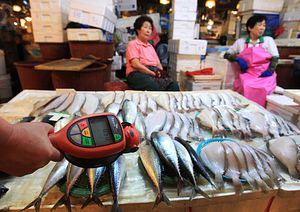March 11 marked the seventh anniversary of the earthquake and tsunami disaster that devastated Japan’s northeast coastal regions in 2011. While the resulting accident at the Fukushima Daiichi nuclear power plant continues to cause a great deal of disruption within the country, it also poses ongoing challenges for Japan’s diplomacy.
The Japanese government recently came under pressure in a United Nations human rights forum over the adequacy of its support for people who fled the disaster zone – and faced scrutiny about radiation levels in places where evacuees have returned. At the same time, Japanese diplomats have been waging a long battle to persuade other countries to ease import restrictions on food from the surrounding areas.
The Fukushima prefectural government says that the number of evacuees peaked at 164,865 in 2012, the year after the disaster, but that figure has now fallen to about 50,000 with decontamination work progressing and the lifting of evacuation orders in a number of towns.
Several countries took up the issue of the rights of Fukushima residents and evacuees as part of the UN’s universal periodic review of Japan. Austria, for example, urged the government to continue to provide housing support to so-called voluntary evacuees. These are people who had been living outside officially designated evacuation zones but fled because of their fears about radiation. Their housing aid ended about a year ago. Portugal, meanwhile, called on Japan to ensure women and men had equal participation in decision-making processes about their resettlement and Mexico urged the government to guarantee access to health services.
Germany’s representatives focused on radiation levels. Under Japanese government policies, evacuation orders can be lifted if the level of exposure for residents is estimated to be below 20 millisievert (mSv) per year. Germany called on the government to “respect the rights of persons living in the area of Fukushima, in particular of pregnant women and children, to the highest level of physical and mental health, notably by restoring the allowable dose of radiation to the 1 mSv/year limit, and by a continuing support to the evacuees and residents.” Incidentally, the International Commission on Radiological Protection recommends that the level for people in contaminated areas should be in the lower part of the 1 to 20 mSv/year range, with a long-term post-accident target of 1 mSv/year.
In a response dated March 1, the Japanese government said it accepted these four recommendations for follow-up, while arguing that it was providing necessary support to affected people under the relevant laws. The minister for reconstruction, Masayoshi Yoshino, subsequently told foreign journalists and diplomats that the government was effectively already committed to the long-term target advocated by Germany. “We have proceeded with decontamination efforts and as a long-term goal the government has indicated 1 mSv per annum,” he said during a briefing at the Foreign Press Center Japan on March 7.
The problem, according to environmental activists, is that the time-frame for achieving that goal is vague. Shaun Burnie, a nuclear specialist at Greenpeace Germany, said the raising of the issue in the UN process was important for evacuees as the recommendations could not simply be ignored. “The German government’s intervention on behalf of tens of thousands of Japanese citizens is absolutely welcome,” he said during a visit to Tokyo. Burnie and others plan to closely monitor how the recommendations are implemented.
Meanwhile, the Japanese government has been seeking to promote the safety of food products from Fukushima and other nearby regions, as a handful of places (including China and Taiwan) still impose import restrictions.
Tokyo last month enjoyed a significant win when a World Trade Organization dispute panel ruled that South Korea’s broad restrictions targeting eight prefectures were “unjustifiably discriminate.” Seoul is appealing the finding.
The Japanese government emphasizes the integrity of its food screening measures. In a recent report to the International Atomic Energy Agency, the government said 25,864 food samples were taken and analyzed in January 2018, of which 19 samples or 0.07 percent were found to be above the limits for cesium-134 and cesium-137.
Yoshino, the reconstruction minister, said vegetables, tea, and livestock products had not exceeded the standard limits over the past five years. No bags of rice produced in Fukushima prefecture had breached the limit since 2015, he added. Yoshino further described the “elimination of negative reputation” as the biggest challenge in promoting reconstruction of disaster-affected areas.
“Hoping that overseas consumers would also experience our delicious foods, I would be grateful if you would tell the people of your country about these initiatives for food safety that I have presented here today,” Yoshino said in a press briefing that was also attended by diplomats.
































